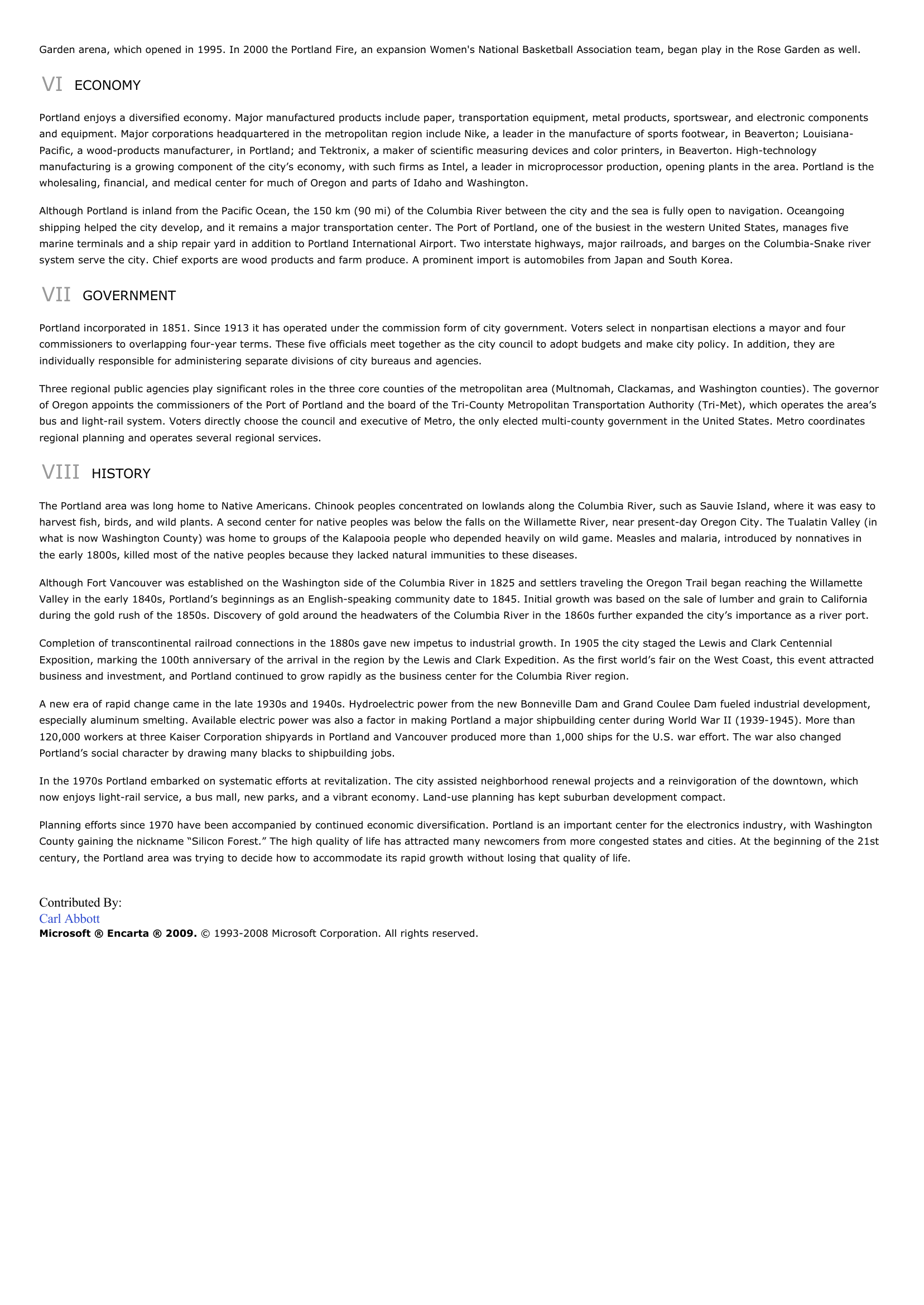Portland - geography.
Publié le 04/05/2013

Extrait du document
«
Garden arena, which opened in 1995.
In 2000 the Portland Fire, an expansion Women's National Basketball Association team, began play in the Rose Garden as well.
VI ECONOMY
Portland enjoys a diversified economy.
Major manufactured products include paper, transportation equipment, metal products, sportswear, and electronic componentsand equipment.
Major corporations headquartered in the metropolitan region include Nike, a leader in the manufacture of sports footwear, in Beaverton; Louisiana-Pacific, a wood-products manufacturer, in Portland; and Tektronix, a maker of scientific measuring devices and color printers, in Beaverton.
High-technologymanufacturing is a growing component of the city’s economy, with such firms as Intel, a leader in microprocessor production, opening plants in the area.
Portland is thewholesaling, financial, and medical center for much of Oregon and parts of Idaho and Washington.
Although Portland is inland from the Pacific Ocean, the 150 km (90 mi) of the Columbia River between the city and the sea is fully open to navigation.
Oceangoingshipping helped the city develop, and it remains a major transportation center.
The Port of Portland, one of the busiest in the western United States, manages fivemarine terminals and a ship repair yard in addition to Portland International Airport.
Two interstate highways, major railroads, and barges on the Columbia-Snake riversystem serve the city.
Chief exports are wood products and farm produce.
A prominent import is automobiles from Japan and South Korea.
VII GOVERNMENT
Portland incorporated in 1851.
Since 1913 it has operated under the commission form of city government.
Voters select in nonpartisan elections a mayor and fourcommissioners to overlapping four-year terms.
These five officials meet together as the city council to adopt budgets and make city policy.
In addition, they areindividually responsible for administering separate divisions of city bureaus and agencies.
Three regional public agencies play significant roles in the three core counties of the metropolitan area (Multnomah, Clackamas, and Washington counties).
The governorof Oregon appoints the commissioners of the Port of Portland and the board of the Tri-County Metropolitan Transportation Authority (Tri-Met), which operates the area’sbus and light-rail system.
Voters directly choose the council and executive of Metro, the only elected multi-county government in the United States.
Metro coordinatesregional planning and operates several regional services.
VIII HISTORY
The Portland area was long home to Native Americans.
Chinook peoples concentrated on lowlands along the Columbia River, such as Sauvie Island, where it was easy toharvest fish, birds, and wild plants.
A second center for native peoples was below the falls on the Willamette River, near present-day Oregon City.
The Tualatin Valley (inwhat is now Washington County) was home to groups of the Kalapooia people who depended heavily on wild game.
Measles and malaria, introduced by nonnatives inthe early 1800s, killed most of the native peoples because they lacked natural immunities to these diseases.
Although Fort Vancouver was established on the Washington side of the Columbia River in 1825 and settlers traveling the Oregon Trail began reaching the WillametteValley in the early 1840s, Portland’s beginnings as an English-speaking community date to 1845.
Initial growth was based on the sale of lumber and grain to Californiaduring the gold rush of the 1850s.
Discovery of gold around the headwaters of the Columbia River in the 1860s further expanded the city’s importance as a river port.
Completion of transcontinental railroad connections in the 1880s gave new impetus to industrial growth.
In 1905 the city staged the Lewis and Clark CentennialExposition, marking the 100th anniversary of the arrival in the region by the Lewis and Clark Expedition.
As the first world’s fair on the West Coast, this event attractedbusiness and investment, and Portland continued to grow rapidly as the business center for the Columbia River region.
A new era of rapid change came in the late 1930s and 1940s.
Hydroelectric power from the new Bonneville Dam and Grand Coulee Dam fueled industrial development,especially aluminum smelting.
Available electric power was also a factor in making Portland a major shipbuilding center during World War II (1939-1945).
More than120,000 workers at three Kaiser Corporation shipyards in Portland and Vancouver produced more than 1,000 ships for the U.S.
war effort.
The war also changedPortland’s social character by drawing many blacks to shipbuilding jobs.
In the 1970s Portland embarked on systematic efforts at revitalization.
The city assisted neighborhood renewal projects and a reinvigoration of the downtown, whichnow enjoys light-rail service, a bus mall, new parks, and a vibrant economy.
Land-use planning has kept suburban development compact.
Planning efforts since 1970 have been accompanied by continued economic diversification.
Portland is an important center for the electronics industry, with WashingtonCounty gaining the nickname “Silicon Forest.” The high quality of life has attracted many newcomers from more congested states and cities.
At the beginning of the 21stcentury, the Portland area was trying to decide how to accommodate its rapid growth without losing that quality of life.
Contributed By:Carl AbbottMicrosoft ® Encarta ® 2009. © 1993-2008 Microsoft Corporation.
All rights reserved..
»
↓↓↓ APERÇU DU DOCUMENT ↓↓↓
Liens utiles
- Portland - geography.
- Tharp Twyla, née en 1940 à Portland (Indiana), danseuse, chorégraphe et directrice de compagnie américaine.
- Longfellow Henry Wadsworth , 1807-1882, né à Portland (Maine), écrivain américain.
- Mark Rothko par Marie-Claude Dane Conservateur Adjoint du Musée d'Art Moderne de la Ville de Paris Né à Dvinsk, en Russie, non loin de la frontière polonaise, Mark Rothko suivra sa famille à Portland, Oregon, en 1913 et terminera ses études à l'université Yale.
- Tokyo - geography.








